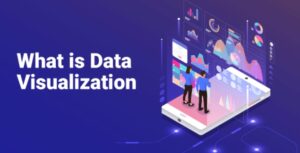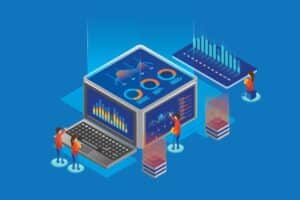As businesses continue to rely on data to inform their decision-making processes, the ability to turn raw data into actionable insights has become more important than ever before. While raw data can be overwhelming and difficult to understand, data visualization offers a powerful solution that helps businesses gain meaningful insights from their data. In this article, we’ll explore the importance of data visualization in business intelligence, and how it can help businesses unlock new opportunities.

I. Introduction
In today’s world, businesses rely heavily on data to make informed decisions. Business Intelligence (BI) is the practice of using data to gain insights that can help businesses make strategic decisions. BI relies on accurate data analysis, which can be difficult to achieve when working with large and complex datasets. Data visualization offers a powerful solution that can help businesses understand and analyze data more effectively.
II. Benefits of Data Visualization
Data visualization is a powerful tool that offers several benefits to businesses, including: ###A. Improved Understanding of Data Visual representations of data can make complex information more understandable. Visualizations help to organize and present data in a way that is easy to comprehend, helping businesses gain deeper insights into their data.
B. Efficient Communication of Information
Data visualization is an effective way to communicate complex data to others. Visualizations make it easy to share data with stakeholders and decision makers, making it easier to present complex data and insights in a way that everyone can understand.
C. Identification of Trends and Patterns
Data visualization helps to identify trends and patterns that may not be immediately obvious. Visualization tools help to highlight important trends and outliers, making it easier to make informed decisions based on data.
D. Better Decision Making
Data visualization helps businesses make better decisions by providing insights into the relationships between different data points. By visualizing data in different ways, businesses can identify relationships and correlations that may not be immediately obvious.
III. Types of Data Visualization
There are several types of data visualizations, each with its own unique strengths and weaknesses. Here are a few of the most common types: ###A. Graphs and Charts Graphs and charts are a simple way to visualize data. They are often used to display data in a clear and concise way, making it easy to compare different data points and identify trends.
B. Infographics
Infographics are a more visual way of displaying data. They often use illustrations and icons to make data more accessible and understandable. Infographics are often used to simplify complex information and make it easier to communicate to a broad audience.
C. Dashboards
Dashboards are a collection of visualizations that display data from different sources in a single view. They are often used to provide an at-a-glance view of important business metrics and KPIs.
D. Maps
Maps are a powerful way to visualize geographical data. They can be used to display data by region, making it easy to identify patterns and trends based on location.
IV. Best Practices for Data Visualization
While data visualization offers several benefits to businesses, it’s important to follow best practices to ensure that visualizations are effective and accurate. Here are a few best practices for data visualization: ###A. Know Your Audience Understanding the needs and preferences of your audience is crucial when creating data visualizations. Visualizations should be tailored to the audience and their level of expertise in the subject matter.
B. Choose the Right Visualization
Choosing the right visualization for your data is important to ensure that the data is accurately represented. Different types of data require different types of visualizations, so it’s important to choose the right one.
C. Keep it Simple
Visualizations should be simple and easy to understand. Overcomplicated visualizations can be overwhelming and difficult to interpret, leading to confusion and misinterpretation of data.
D. Use Color Effectively
Color can be used to highlight important data points and make visualizations more engaging. However, it’s important to use color effectively to avoid confusion and misinterpretation of data.
E. Label Clearly
Clear labeling is important to ensure that visualizations are accurate and easy to understand. Labels should be clear and concise, and avoid using abbreviations or acronyms that may not be familiar to all users.
F. Update Regularly
Visualizations should be updated regularly to ensure that they accurately reflect the most current data. Regular updates help to ensure that decision-making is based on accurate and up-to-date information.
V. Common Data Visualization Tools
There are several data visualization tools available on the market today. Here are a few of the most common:
A. Microsoft Power BI
Microsoft Power BI is a popular data visualization tool that allows users to create custom visualizations and dashboards. It offers a range of data connectors that allow users to connect to a variety of data sources.
B. Tableau
Tableau is a data visualization tool that allows users to create interactive visualizations and dashboards. It offers a range of data connectors and supports real-time data analysis.
C. QlikView
QlikView is a data visualization tool that offers real-time data analysis and allows users to create custom dashboards and visualizations. It offers a range of data connectors and supports multiple data sources.
D. Google Data Studio
Google Data Studio is a free data visualization tool that allows users to create custom visualizations and dashboards. It offers a range of data connectors and integrates with other Google products.
VI. FAQ
A. What is the best way to choose the right visualization for my data?
The best way to choose the right visualization for your data is to consider the type of data you are working with and the story you want to tell. Different types of data require different types of visualizations, so it’s important to choose the one that best represents the data.
B. What are some common mistakes to avoid when creating data visualizations?
Common mistakes to avoid when creating data visualizations include overcomplicating visualizations, using inappropriate color schemes, and failing to label visualizations clearly.
C. How can I make sure my data visualizations are accessible to all users?
To ensure that your data visualizations are accessible to all users, it’s important to use clear and concise labeling, avoid using abbreviations or acronyms, and provide alternative text descriptions for users who may have visual impairments. You should also test your visualizations with a diverse group of users to ensure that they are easy to understand and accessible to everyone.
VII. Conclusion
Data visualization is a powerful tool that can help businesses gain valuable insights from their data. By visualizing data in different ways, businesses can identify trends, patterns, and relationships that may not be immediately obvious. However, it’s important to follow best practices and choose the right visualization for your data to ensure that your visualizations are accurate, effective, and accessible to all users. With the right data visualization tools and techniques, businesses can unlock new opportunities and make informed decisions that drive growth and success.
